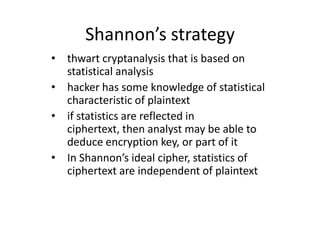Recommended
Recommended
More Related Content
Similar to Shannon’s strategy
Similar to Shannon’s strategy (20)
Quantum cryptography by Girisha Shankar, Sr. Manager, Cisco

Quantum cryptography by Girisha Shankar, Sr. Manager, Cisco
3. The Data Encryption Standard (DES) and Alternatives

3. The Data Encryption Standard (DES) and Alternatives
Shannon’s strategy
- 1. Shannon’s strategy • thwart cryptanalysis that is based on statistical analysis • hacker has some knowledge of statistical characteristic of plaintext • if statistics are reflected in ciphertext, then analyst may be able to deduce encryption key, or part of it • In Shannon’s ideal cipher, statistics of ciphertext are independent of plaintext
- 2. Shannon’s building blocks confusion make relation between statistics of ciphertext and the value of the encryption key as complex as possible diffusion diffuse statistical property of plaintext digit across a range of ciphertext digits i.e. each plaintext digits affects value of many ciphertext digits
- 3. Feistel cipher • input plaintext of 2w bits • key K = n sub-keys: K1, K2, …, Kn • The plain text is divided into 2 halves Lo and Ro • sequence of n “rounds” each using Ki • substitution followed by a permutation • apply function F(Ki) to right half of data, then exclusive-OR it to left half of data • permutation: interchange two result halves of data • Li+1=Ri Ri+1=Li F(Li+1,Ki)
- 5. Feistel Cipher Design Principles • block size – increasing size improves security, but slows cipher • key size – increasing size improves security, makes exhaustive key searching harder, but may slow cipher • number of rounds – increasing number improves security, but slows cipher • subkey generation – greater complexity can make analysis harder, but slows cipher • round function – greater complexity can make analysis harder, but slows cipher • fast software en/decryption & ease of analysis – are more recent concerns for practical use and testing
- 6. Feistel Cipher Encryption and Decryption
- 7. Decryption • Ri=Li+1 Li=Ri+1 F(Li+1,Ki)
